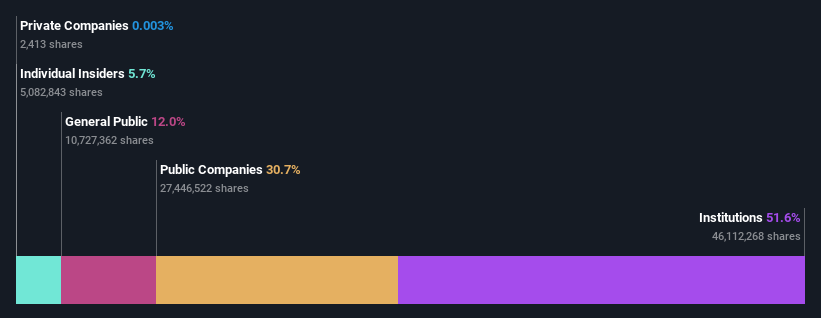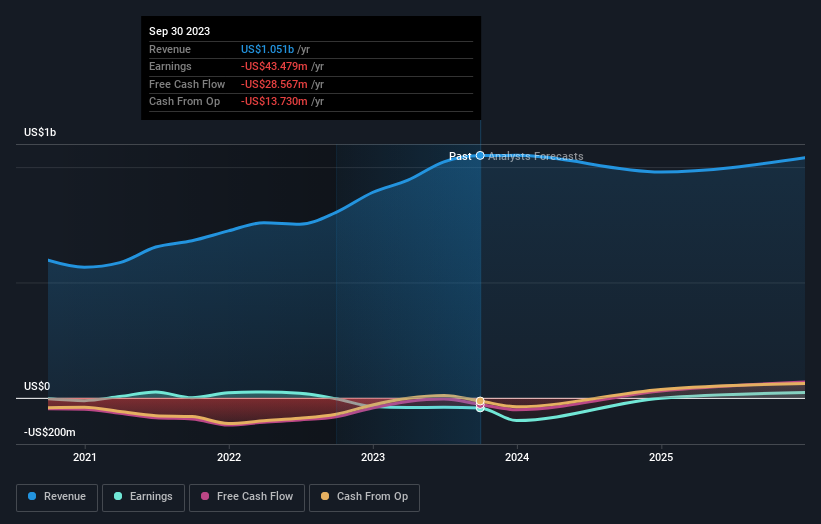Stock Analysis
- United States
- /
- Electrical
- /
- NYSE:BW
Institutional investors may adopt severe steps after Babcock & Wilcox Enterprises, Inc.'s (NYSE:BW) latest 13% drop adds to a year losses

Key Insights
- Significantly high institutional ownership implies Babcock & Wilcox Enterprises' stock price is sensitive to their trading actions
- 51% of the business is held by the top 5 shareholders
- Insiders have bought recently
Every investor in Babcock & Wilcox Enterprises, Inc. (NYSE:BW) should be aware of the most powerful shareholder groups. We can see that institutions own the lion's share in the company with 52% ownership. In other words, the group stands to gain the most (or lose the most) from their investment into the company.
And so it follows that institutional investors was the group most impacted after the company's market cap fell to US$109m last week after a 13% drop in the share price. Needless to say, the recent loss which further adds to the one-year loss to shareholders of 83% might not go down well especially with this category of shareholders. Often called “market movers", institutions wield significant power in influencing the price dynamics of any stock. Hence, if weakness in Babcock & Wilcox Enterprises' share price continues, institutional investors may feel compelled to sell the stock, which might not be ideal for individual investors.
In the chart below, we zoom in on the different ownership groups of Babcock & Wilcox Enterprises.
See our latest analysis for Babcock & Wilcox Enterprises

What Does The Institutional Ownership Tell Us About Babcock & Wilcox Enterprises?
Many institutions measure their performance against an index that approximates the local market. So they usually pay more attention to companies that are included in major indices.
Babcock & Wilcox Enterprises already has institutions on the share registry. Indeed, they own a respectable stake in the company. This implies the analysts working for those institutions have looked at the stock and they like it. But just like anyone else, they could be wrong. If multiple institutions change their view on a stock at the same time, you could see the share price drop fast. It's therefore worth looking at Babcock & Wilcox Enterprises' earnings history below. Of course, the future is what really matters.

Institutional investors own over 50% of the company, so together than can probably strongly influence board decisions. Hedge funds don't have many shares in Babcock & Wilcox Enterprises. B. Riley Financial, Inc. is currently the largest shareholder, with 31% of shares outstanding. For context, the second largest shareholder holds about 7.2% of the shares outstanding, followed by an ownership of 4.5% by the third-largest shareholder. In addition, we found that Kenneth Young, the CEO has 1.7% of the shares allocated to their name.
On looking further, we found that 51% of the shares are owned by the top 5 shareholders. In other words, these shareholders have a meaningful say in the decisions of the company.
Researching institutional ownership is a good way to gauge and filter a stock's expected performance. The same can be achieved by studying analyst sentiments. There are a reasonable number of analysts covering the stock, so it might be useful to find out their aggregate view on the future.
Insider Ownership Of Babcock & Wilcox Enterprises
The definition of company insiders can be subjective and does vary between jurisdictions. Our data reflects individual insiders, capturing board members at the very least. Management ultimately answers to the board. However, it is not uncommon for managers to be executive board members, especially if they are a founder or the CEO.
Most consider insider ownership a positive because it can indicate the board is well aligned with other shareholders. However, on some occasions too much power is concentrated within this group.
We can report that insiders do own shares in Babcock & Wilcox Enterprises, Inc.. It has a market capitalization of just US$109m, and insiders have US$6.2m worth of shares, in their own names. Some would say this shows alignment of interests between shareholders and the board, though we generally prefer to see bigger insider holdings. But it might be worth checking if those insiders have been selling.
General Public Ownership
With a 12% ownership, the general public, mostly comprising of individual investors, have some degree of sway over Babcock & Wilcox Enterprises. While this group can't necessarily call the shots, it can certainly have a real influence on how the company is run.
Public Company Ownership
It appears to us that public companies own 31% of Babcock & Wilcox Enterprises. We can't be certain but it is quite possible this is a strategic stake. The businesses may be similar, or work together.
Next Steps:
It's always worth thinking about the different groups who own shares in a company. But to understand Babcock & Wilcox Enterprises better, we need to consider many other factors. For example, we've discovered 2 warning signs for Babcock & Wilcox Enterprises that you should be aware of before investing here.
But ultimately it is the future, not the past, that will determine how well the owners of this business will do. Therefore we think it advisable to take a look at this free report showing whether analysts are predicting a brighter future.
NB: Figures in this article are calculated using data from the last twelve months, which refer to the 12-month period ending on the last date of the month the financial statement is dated. This may not be consistent with full year annual report figures.
Valuation is complex, but we're helping make it simple.
Find out whether Babcock & Wilcox Enterprises is potentially over or undervalued by checking out our comprehensive analysis, which includes fair value estimates, risks and warnings, dividends, insider transactions and financial health.
View the Free AnalysisHave feedback on this article? Concerned about the content? Get in touch with us directly. Alternatively, email editorial-team (at) simplywallst.com.
This article by Simply Wall St is general in nature. We provide commentary based on historical data and analyst forecasts only using an unbiased methodology and our articles are not intended to be financial advice. It does not constitute a recommendation to buy or sell any stock, and does not take account of your objectives, or your financial situation. We aim to bring you long-term focused analysis driven by fundamental data. Note that our analysis may not factor in the latest price-sensitive company announcements or qualitative material. Simply Wall St has no position in any stocks mentioned.
About NYSE:BW
Babcock & Wilcox Enterprises
Provides energy and emissions control solutions to industrial, electrical utility, municipal, and other customers worldwide.
Undervalued with moderate growth potential.


